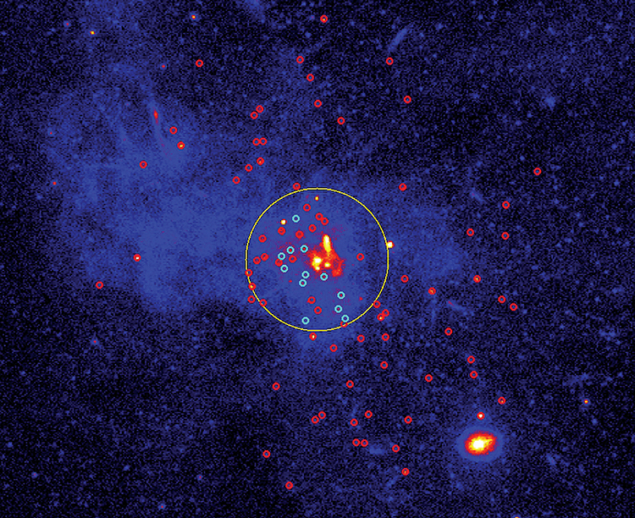
For decades, theoretical models of galaxy evolution have predicted that the supermassive black hole lying at the heart of the Milky Way is surrounded by thousands of smaller black holes left behind by dying stars. Testing such theories is important to understand our own galaxy and, more generally, to understand how galaxies evolve and how black holes are produced. Now, observations by NASA’s Chandra X-ray Observatory have revealed a dozen stellar-mass black holes at the centre of the galaxy, providing the first observational evidence for such a black-hole cluster.
Black holes emit virtually no radiation, so it’s not possible to detect them when they are isolated and located at large distances from Earth. But many black holes have close stellar companions from which they accrete matter and, as this matter is sucked into the black hole, it heats up and emits X-rays that can be detected on Earth. If only a few of the thousands of the stellar-mass black holes that are predicted to exist in the galactic centre had a companion star, at least this binary fraction of the total black-hole population would be detectable by X-ray telescopes.
Using Chandra data, a group led by Chuck Hailey of Columbia University in New York searched for such black-hole binary systems in a region extending several light years from the galactic centre. This type of search is confounded by two aspects: the high density of other X-ray-emitting objects in the same region, such as binary systems containing neutron stars or white dwarfs instead of black holes; and the relatively low intensity of the X-ray binary sources in the region. But in their study, Hailey and colleagues were able to distinguish between the different types of weak X-ray binary system in the region by studying their spectra.
The researchers examined the Chandra spectra of 415 weak X-ray point sources, containing as few as 100 counts, and looked for the expected spectral features of black-hole binaries. They found 12 sources that have the expected spectral characteristics of black-hole binaries, all within a radius of three light years from the supermassive black hole (see figure). Other X-ray sources whose spectra match well with those of white-dwarf binary systems were found to be distributed at larger distances from the galactic centre.
The researchers went on to estimate the total number of black-hole binary systems in the observed region, assuming that the 12 sources are the brightest in their family and using the known fluxes of brighter and well-studied black-hole binary systems. This resulted in about 300–1000 binary black holes, which is a lower limit on the total number because it only includes those with companion stars. According to theoretical follow-up work by Aleksey Generozov of Columbia and colleagues, the total number of black holes should be between 10,000 and 40,000.
The results, published in Nature, agree with the theoretical predictions and therefore confirm the existing models of galaxy evolution. What’s more, the findings allow astronomers to predict the number of black-hole mergers – and thus the number of gravitational waves – from this region.
Further reading
C J Hailey et al. 2018 Nature 556 70.








